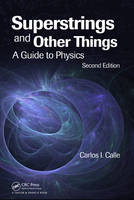
Superstrings and Other Things
Taylor & Francis Inc (Verlag)
978-1-4398-1073-6 (ISBN)
- Titel erscheint in neuer Auflage
- Artikel merken
A research scientist at NASA working on planetary exploration, Carlos Calle has the opportunity to ponder what seems imponderable, but while that might make Dr. Calle unusual, what makes him truly special is his ability to translate the algebraic formulas and calculus-based logic into concepts that can be appreciated and held in awe by those in possession of tools no more sophisticated than curiosity and imagination.
Superstrings and Other Things: A Guide to Physics, Second Edition continues to take the interested on a uniquely accessible journey through physics. This guide explains the basic concepts of motion, energy, and gravity, right up through the latest theories about the structure of matter, the origin of the universe, and the beginning of time. Fully illustrated throughout, the book explores major discoveries and the scientists behind them, from Galileo, Newton, and Einstein, to Feynman and Hawking. Numerous examples of physics in everyday situations are provided and made tangible.
When Dr. Calle wrote the first edition of this bestseller, even he would have been surprised by the newest development in String Theory, the far reaching M-Theory. In addition to details about M-Theory, he adds a number of other surprises and updated material for this edition. Not only will you be rewarded with a basic understanding of the fundamental concepts of physics, but you will also come to have the chance to stand on the very edge of the breathtaking frontiers of physics today.
Offers non-science students and others access to the highest peaks of physics
Supports a truly conceptual approach to teaching physics without advanced math, emphazing concepts and ideas rather than equations
Provides up-to-date coverage of modern physics and showcases modern applications of physics in our everyday world
Now includes a Solutions Manual with qualifying course adoptions
Carlos I. Calle is a senior research physicist at NASA Kennedy Space Center and the founder and director of NASA’s Electrostatics and Surface Physics Laboratory. He is the recipient of numerous NASA awards for exceptional contributions to the space program and outstanding support of the Space Shuttle Program. With his laboratory staff, he has developed technologies for NASA’s lunar and Martian exploration programs and has also developed new testing techniques for several Space Shuttle systems. As a professor of physics during the early part of his career, he taught the whole range of college physics courses. He has published over 150 scientific papers and other popular books on physics.
Carlos I. Calle is a senior research physicist at NASA Kennedy Space Center and the founder and director of NASA’s Electrostatics and Surface Physics Laboratory. He is the recipient of numerous NASA awards for exceptional contributions to the space program and outstanding support of the Space Shuttle Program. With his laboratory staff, he has developed technologies for NASA’s lunar and Martian exploration programs and has also developed new testing techniques for several Space Shuttle systems. As a professor of physics during the early part of his career, he taught the whole range of college physics courses. He has published over 150 scientific papers and other popular books on physics.
Part I Introductory Concepts
Chapter 1. Physics: The Fundamental Science
What Is Physics?
The Scientific Method: Learning from Our Mistakes
Physics and Other Sciences
Sizes of Things: Measurement
Fundamental Units
Physics and Mathematics
Part II The Laws of Mechanics
Chapter 2. The Description of Motion
Understanding Motion
Uniform Motion
Average Speed
Instantaneous Speed
Velocity: Speed and Direction
Vectors
Acceleration
Uniformly Accelerated Motion
Falling Bodies
The Motion of Projectiles
Chapter 3. The Laws of Mechanics: Newton’s Laws of Motion
The Concept of Force
The Ancient Idea of Motion
The Birth of Modern Science
Galileo Formulates the Law of Inertia
Newton’s First Law: The Law of Inertia
Newton’s Second Law: The Law of Force
Newton’s Third Law: The Law of Action and Reaction
Chapter 4. Energy
What Is Energy?
The Concept of Work
Units of Work and Energy
The Concept of Energy
Energy of Motion
Energy of Position
Elastic Potential Energy
The Work–Energy Theorem
Conservative and Nonconservative Forces
Chapter 5. Conservation of Energy and Momentum
Transformation of Energy
The Principle of Conservation of Energy
The Energy of Mass
Efficiency
Power
Impulse and Momentum
Conservation of Momentum
Elastic and Inelastic Collisions
Cannons and Rockets
Chapter 6. Rotation and the Universal Law of Gravitation
Rotational Motion
Torque and Angular Momentum
Centripetal Acceleration
Satellites
Origins of Our View of the Universe
Kepler’s Laws of Planetary Motion
Newton’s Law of Universal Gravitation
Spacecraft and Orbital Motion
Part III The Structure of Matter
Chapter 7. Atoms: Building Blocks of the Universe
The Underlying Structure of Matter
The Atomic Hypothesis
Early Concept of the Atom
First Models of the Atom
Waves and Quanta
The Bohr Model of the Atom
Compounds
Chapter 8. The Heart of the Atom: The Nucleus
Raw Material: Protons and Neutrons
The Composition of the Nucleus
The Glue That Keeps the Nucleus Together
Size and Shape of the Nucleus
Nuclear Energy Levels
Chapter 9. Fluids
States of Matter
Density
Pressure
Atmospheric Pressure
Pressure in a Liquid
Buoyancy
Surface Tension and Capillarity
Fluids in Motion
The Human Cardiovascular System
Part IV Thermodynamics
Chapter 10. Heat and Temperature
Heat as a Form of Energy
Measuring Temperature
Temperature and Heat
Heat Capacity
Heat of Fusion and Heat of Vaporization
Evaporation and Boiling
Humidity
Thermal Expansion
The Unusual Expansion of Water
Chapter 11. The Laws of Thermodynamics
The Four Laws of Thermodynamics
The Ideal Gas Law
The Zeroth Law of Thermodynamics
The First Law of Thermodynamics
The Second Law of Thermodynamics
The Third Law of Thermodynamics
Entropy and the Origin of the Universe
Entropy and the Arrow of Time
Part V Electricity and Magnetism
Chapter 12. Electricity
Electromagnetism
Electric Charge
Coulomb’s Law
The Electric Field
The Fundamental Charge
Electric Potential
Storing Electrical Energy
Chapter 13. Applied Electricity
Conductors and Insulators
Electric Current and Batteries
Ohm’s Law
Simple Electric Circuits
Resistor Combinations
Electrical Energy and Power
Semiconductors
Superconductors
Chapter 14. Electromagnetism
The Discovery of Magnets
The Magnetic Field
Electric Currents and Magnetism
A Moving Charge in a Magnetic Field
Particle Accelerators
Magnetism of the Earth
The Source of Magnetism
Faraday’s Law of Induction
Motors and Generators
Maxwell’s Equations
Part VI Waves
Chapter 15. Wave Motion
The Nature of Waves
Properties of Waves
Diffraction
The Principle of Superposition
Constructive and Destructive Interference
Standing Waves
Resonance and Chaos
Water Waves
Seismic Waves
Chapter 16. Sound
The Nature of Sound
The Speed of Sound
Intensity of Sound Waves
The Ear
The Sound of Music
Musical Instruments
The Doppler Effect
Shockwaves
Ultrasound
Chapter 17. Optics
Waves of Light
Reflection of Light
Reflection from Mirrors
Curved Mirrors
Refraction of Light
Lenses
Total Internal Reflection
Fiber Optics
Optical Instruments
The Camera
The Telescope
The Human Eye
Chapter 18. The Nature of Light
The Wave Nature of Light
The Speed of Light
The Electromagnetic Spectrum
Color
Spectra: The Signature of Atoms
Young’s Experiment
Polarization
Lasers
Holography
Part VII Modern Physics
Chapter 19. The Special Theory of Relativity
Galilean Relativity
The Michelson–Morley Experiment
Einstein’s Postulates
Time Dilation
Simultaneity
Length Contraction
Addition of Velocities
E = mc2
Chapter 20. The General Theory of Relativity
The Principle of Equivalence
Warped Space–Time Continuum
The Bending of Light
The Perihelion of Mercury
The Gravitational Time Dilation
Black Holes
Chapter 21. The Early Atomic Theory
The Physics of the Atom
Black Body Radiation
The Photoelectric Effect
The Bohr Model of the Atom Revisited
De Broglie’s Waves
Quantum Mechanics
Chapter 22. Quantum Mechanics
The Beginnings of Quantum Mechanics
The new mechanics of the atom
Wave mechanics
Heisenberg’s uncertainty principle
The new physics
Chapter 23. Nuclear Physics
Beyond the atom
Radioactivity
Alpha decay
Beta decay
Gamma decay
Half-life
Nuclear Reactions
Nuclear Energy: Fission and Fusion
Nuclear fission
Nuclear fusion
Applications of Nuclear Physics
Radioactive dating
Biological effects of radioactivity
Chapter 24. Elementary Particles
Antimatter
The fundamental forces
Exchange forces
Pions
Particle classification: Hadrons and leptons
Conservation laws
Strange particles
Quarks
Particles with charm
Three generations
Chapter 25. Unifying Physics
Symmetry
Global and local symmetries
The electroweak unification
The color force
An attempt at a third unification
The Standard Model
Chapter 26. Superstrings
Supersymmetry
Superstrings
M-Theory
The origin of the universe
The first moments of the universe
Appendix A: Powers of Ten
Appendix B: The Elements
Appendix C: Nobel Prize Winners in Physics
Appendix D: Physics Timeline
Appendix E: Discover What You Have Learned
Glossary
Index
| Erscheint lt. Verlag | 22.12.2009 |
|---|---|
| Zusatzinfo | 4-page color insert containing 9 figures; About 100 unnumbered equations; 108 Tables, black and white; 9 Illustrations, color; 376 Illustrations, black and white |
| Verlagsort | Washington |
| Sprache | englisch |
| Maße | 156 x 235 mm |
| Gewicht | 771 g |
| Themenwelt | Sachbuch/Ratgeber ► Natur / Technik |
| Naturwissenschaften ► Physik / Astronomie | |
| ISBN-10 | 1-4398-1073-7 / 1439810737 |
| ISBN-13 | 978-1-4398-1073-6 / 9781439810736 |
| Zustand | Neuware |
| Haben Sie eine Frage zum Produkt? |
aus dem Bereich



